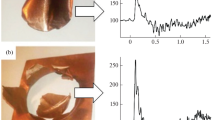Abstract
When a pressure wave propagates along a constant area straight tube and reaches at the open end, an impulsive wave is emitted outward from the tube exit toward the surrounding area and causes an impulsive noise like a sonic boom. In order to clarify the magnitude of an impulsive wave obtained by the discharge of a weak shock wave from an open end of a tube in relation to the noise problem and the industrial devices, the experimental and numerical investigations have been carried out for various strength of a shock wave. A simple open end shock tube with the flange at the tube exit was used and the numerical calculation using the TVD scheme was performed. The effective equations which concerns with the magnitude of an impulsive wave generated by the emission of a shock wave have been obtained from the procedure of the open end correction based on the aeroacoustic theory and the numerical results. The influence of open end correction length and the diameter of a flange on the magnitude of an impulsive wave has been discussed.
Similar content being viewed by others
References
Matsuo, K., et al., “Generation Mechanism of Impulsive Wave Emitted from High-Speed Railway Tunnel Exit”, Proc. of 8th Int. Symp. on Aerodynamics and Ventilation of Vehicle Tunnel, pp.199–209, (1994).
Westine, P. S., “The Blast Field about the Muzzle of Guns”, Shock and Vib. Digest Bull., 39–6, pp.139–149, (1969).
Pennelegion, L. and Grimshaw, J. F., “The Diffraction of the Blast Wave Emerging from a Conical Nozzle Driven by Compressed Gas”, Proc. 12th Int. Symp. Shock Tubes and Waves, pp.349–358, (1979).
Stollery, J. L. et al., “Simulation of Blast Fields by Hydraulic Analogy”, Proc. 13th Int. Symp. Shock Tubes and Waves, pp.781–789, (1981).
Phan, K. C., et al., “Blast Wave Investigation using a High Enthalpy Blast Simulator”, Proc. 17th Int. Symp. Shock Tubes and Waves, pp.903–908, (1989).
Croes, N., “The Principle of the Pressure Wave Machine as used for Charging Diesel Engines”, Proc. 11th Int. Symp. Shock Tubes and Waves, pp.36–55, (1977).
Eidelman, S., et al., “A Propulsion Device Driven by Reflected Shock Waves”, Shock Waves II, pp.1283–1288, (1992).
Ruppert, K. A., et al., “The Effectiveness of Multiple Pressure Pulses in Cleaning of Filter Bags”, Ger. Chem. Eng., 7, pp.345–349, (1984).
Yee, H. C., “Upwind and Symmetric Shock-Capturing Schemes”, NASA TM 89464, pp.1–127, (1987).
Sod, G. A., “A Numerical Study of a Converging Cylindrical Shock”, J. Fluid Mech.,83, Part 4, pp.785–794, (1977).
Blake, W. K., “Mechanics of Flow-Induced Sound and Vibration I”, Academic Press., pp.80–240, (1986).
Rayleigh, J. W. S., “The Theory of Sound”, Dover, pp.183, (1945).
Author information
Authors and Affiliations
Rights and permissions
About this article
Cite this article
Kashimura, H., Yasunobu, T., Nakayama, H. et al. Discharge of a shock wave from an open end of a tube. J. of Therm. Sci. 9, 30–36 (2000). https://doi.org/10.1007/s11630-000-0042-x
Issue Date:
DOI: https://doi.org/10.1007/s11630-000-0042-x




